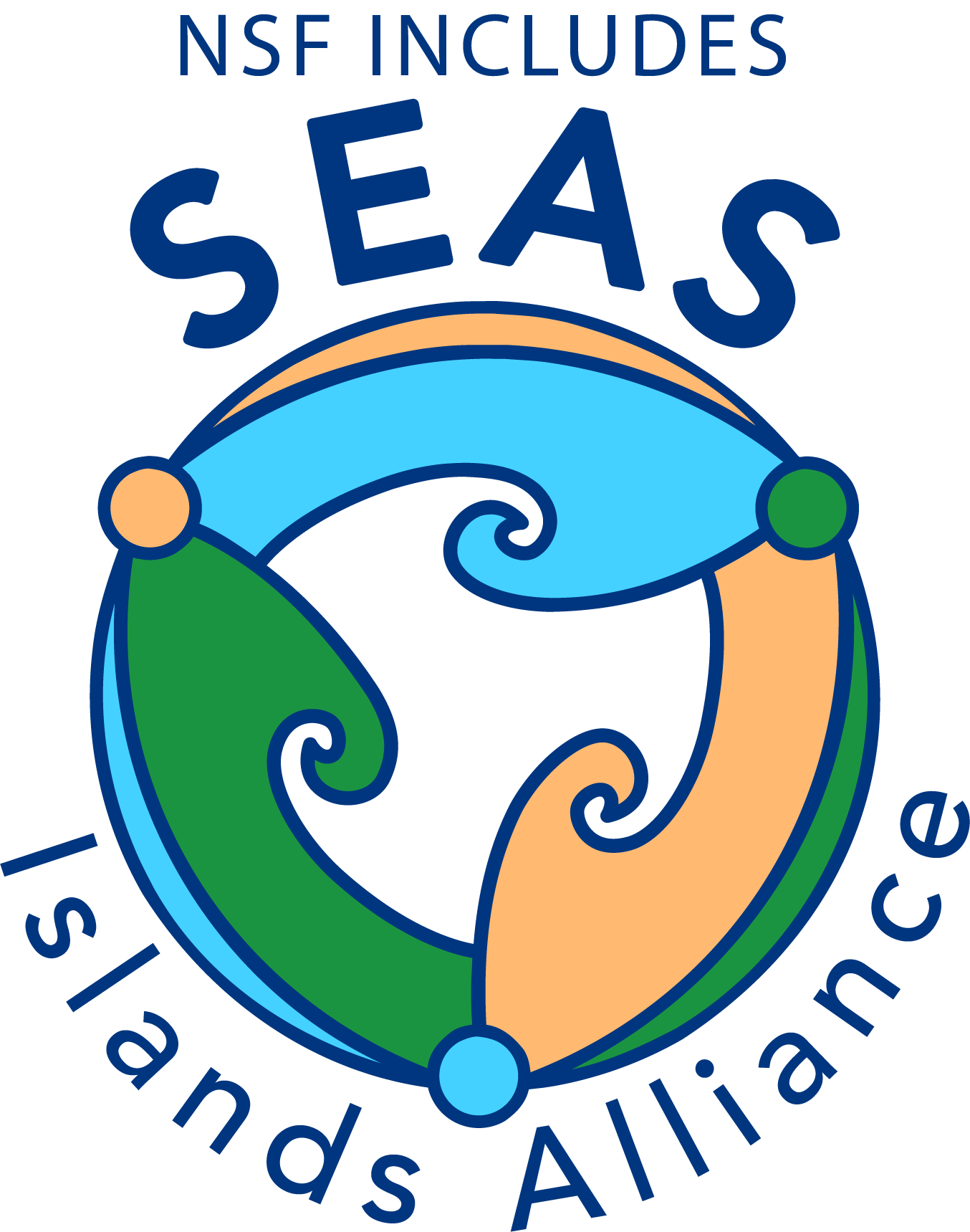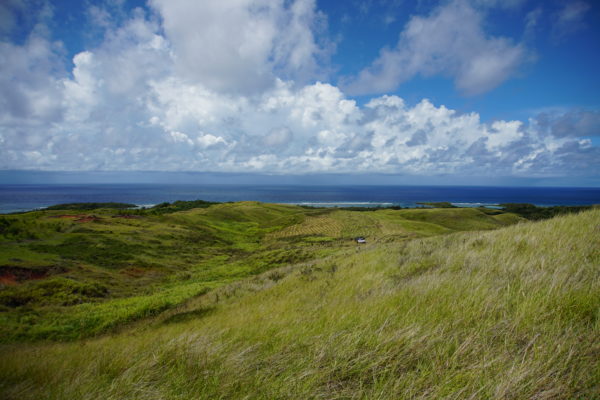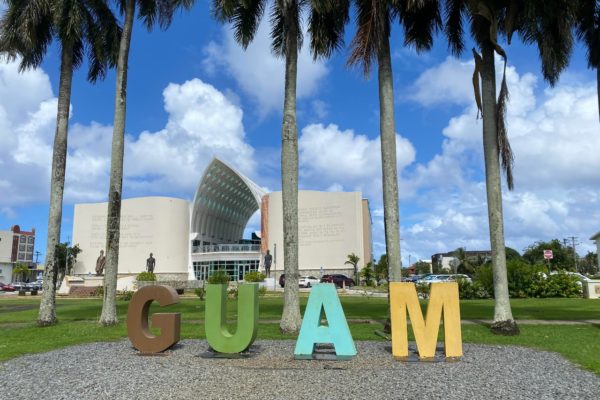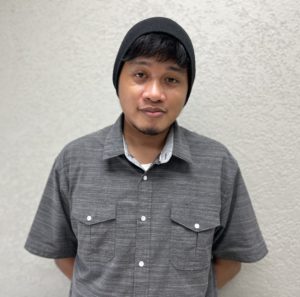 Meet Rhiden Moreno, a recent graduate of Palau Community College. Moreno joined the SEAS Islands Alliance in Guam in the summer of 2022 for a Bridge to Bachelor’s Program internship.
Meet Rhiden Moreno, a recent graduate of Palau Community College. Moreno joined the SEAS Islands Alliance in Guam in the summer of 2022 for a Bridge to Bachelor’s Program internship.
Tell me about yourself.
My name is Rhiden Moreno. I was born and raised in Palau, but I’m actually Filipino. I’m a recent graduate. I did a two-year course at Palau Community College, and my major was environmental science.
Congratulations on wrapping that up. How did you first get interested in science?
What pulled me into science is where I live. It’s a major influence in my life. Not to boast or anything, but Palau is pretty pristine and clean. You can see how untouched this land is, and a lot of people here are into the environment. That’s an important part of their culture and their nature—to conserve and preserve the environment.
When I was a kid, we had a lot of field trips where I was exposed to environmental projects. Elementary schools here have to add a community project to field trips—like tree plantings, coastal cleanups, or local farming. We were exposed to all that at a very young age. It’s pretty neat.
How did you learn about the SEAS Islands Alliance and the Bridge to Bachelor’s Program?
I was at the community college this summer, and one of the recommended internships was in Guam through the SEAS Islands Alliance with Dr. Cheryl Sangueza. My internship was from June 15 to July 15. It was fun, and it wasn’t just me. I also had a buddy of mine here in Palau. We both went to Guam.
What did you study during your internship?
For my internship, we did a research study along with Dr. Christopher Lobban. We were looking into the endemicity of diatoms in different parts of Micronesia. We had students send mangrove mud samples from Palau, Saipan, and the Marshall Islands. We collected the samples, did research, and then presented it there in Guam.
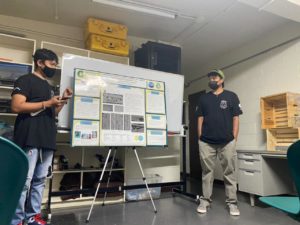
Rhiden Moreno (right) and a fellow student present their research in Guam.
And what does diatom research look like day to day?
We actually sent samples to Guam that we collected here in Palau’s mangroves. The area where I collected mangrove mud used to be a crocodile farm. My friends were all teasing me like, “Be careful, there used to be crocodiles there.” My teammate collected samples in the middle of the island. He was knee-deep in mud, so his boots kept getting stuck. Sample collection could be fun but sometimes scary. [laughs]
While we were in Guam, we were stationed at Dr. Lobban’s lab. He has his own research station all about diatoms. We were given the task to look for a specific diatom called Gyrosigma. That’s a sigmoid-shaped diatom, and it could have a lot of different subspecies. We would identify if it’s endemic only to Palau or if it could be found in Saipan or Guam. It was a fun experience. We got to see the diatoms under a really strong microscope, the scanning electron microscope (SEM), which we’d never held before. Dr. Lobban expressed that it’s a very expensive microscope, so we were really cautious.
Did you find the diatoms you were looking for?
Yeah, we did find two endemic species of diatoms here in Palau. My internship was a branch off from a main research project of one of the graduate students at the University of Guam, Khazmyne Kawamoto. So, she was doing the actual research and we were helping. She actually presented the research at the National Diversity in STEM Conference in Puerto Rico, and she credited all of us who helped.
What did you think of that research experience?
I don’t know if one month is enough, because it was a lot of fun doing research. We got to explore outside, so we weren’t just stuck in a lab. We did some in-field research sample collections around Guam. And I wasn’t only exposed to the diatomic research. We were able to explore other facilities around the university. There’s a lot of stuff I was interested in because it’s also found here in Palau, like coral and jellyfish research. Palau is well-known for its Jellyfish Lake, where they have stingless jellyfish. Guam had a lot of research facilities that I wanted to visit. I personally had fun with it. I would love to go back to Guam and do more research. If there’s a chance, I don’t think I would hesitate to take it.
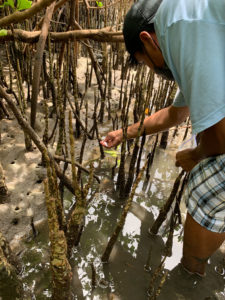
Rhiden Moreno collects mangrove mud samples in Palau.
Was any part of your internship especially memorable?
The entirety of the thing was fun. Being exposed to other people’s research projects while we visited different facilities was very interesting for me, even more than going out on field trips. I like looking into people’s lifetime’s worth of work, what their research is about, and what they dedicated their life to. That’s a major interest for me. There’s this professor who was doing research about how you can determine the age of a fish based on a bone in its brain. That’s something I had never heard of before, so that one was really mind-boggling for me.
What did you think of your peers and program mentors?
My mentor Khazmyne, who presented at the National Diversity in STEM Conference, was really fun. She brought us on field trips off campus, along with our professors. Dr. Cheryl had us attend a coastal cleanup in Guam near an old church. Khazmyne also brought us to a theme park. That’s when I found out that I didn’t like rides. [laughs] I think that’s the only part I didn’t like. I love every part of science, just don’t bring me to any more amusement parks.
What’s next for you now that you’ve completed your two-year program at Palau Community College?
Later on, I’ll be looking for my bachelor’s degree somewhere in the Philippines or back in Guam. Right now, I’m applying to be a teacher for elementary students. I did some tutoring back in college, but this is going to be my first time mentoring little kids. I don’t know if it’s going to be any different. I hope it’s a little bit easier.
Do you think you’ll return to Palau after your bachelor’s degree? Is there a large scientific community?
I’ve been living here my entire life, so most likely I’ll be staying here in Palau. Our scientific community is the locals, so their science is based on their culture. Everything conservation related is their science. I thought I’d probably work as a research assistant here in Palau, doing community work with the locals. We have a research facility called Palau International Coral Reef Center (PICRC) that I’m really interested in. My senior graduate classmate did an internship with PICRC. He did research about corals, how they are resistant to increased water temperatures, and how they are important for protecting us from typhoons. He did a lot of community work based on his research, and that was a major influence on my decision to become an environmental science student.
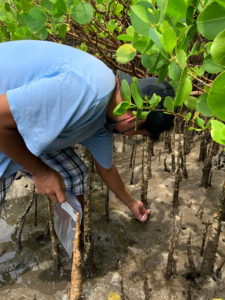
Rhiden Moreno collects mangrove mud samples in Palau.
Do you have any advice for students interested in environmental science?
Well, it’s not advice, but I wish external science would be more open to the younger people here in Palau—not only college students but also high school students. It’s only when you apply for an internship during your last year in college here in Palau that you learn about science opportunities like the SEAS Islands Alliance. The other intern who came with me to Guam was a liberal arts student. When he went to Guam, he actually changed his major to environmental science. It made a really big impact on him. Being exposed to science at an earlier age could be a major influence later. So, that’s what I’m trying to say. I hope these science organizations will do more with the younger generation.
Is there anything else you’d like to share?
There’s nothing negative that I could say about my experience in SEAS. All of what they did was really what they promised. You will get a lot of research experience and a lot of fun out of it.
Interview by Ashley Goetz, science writer and digital specialist with Maryland Sea Grant.
